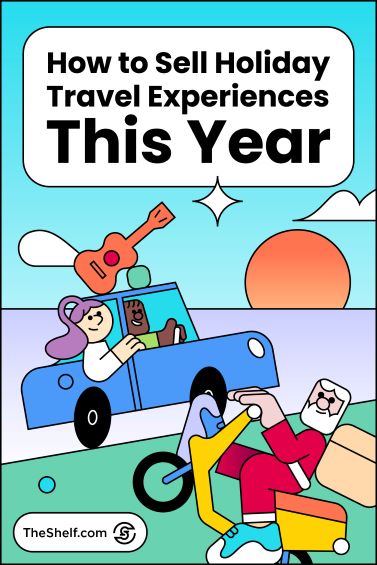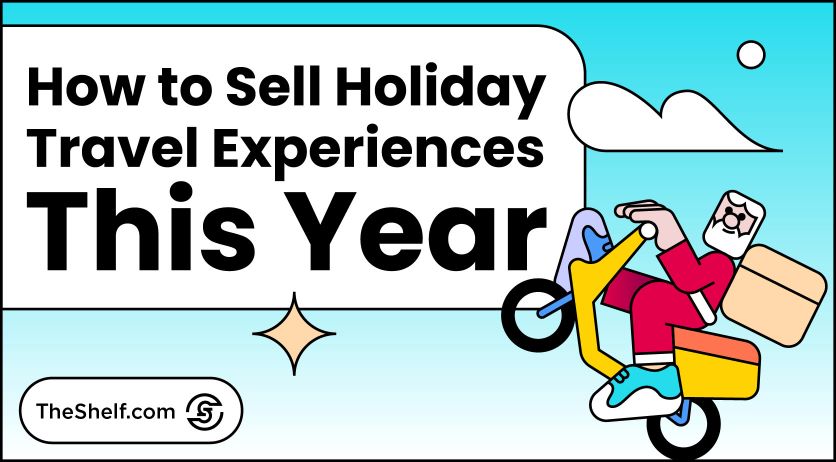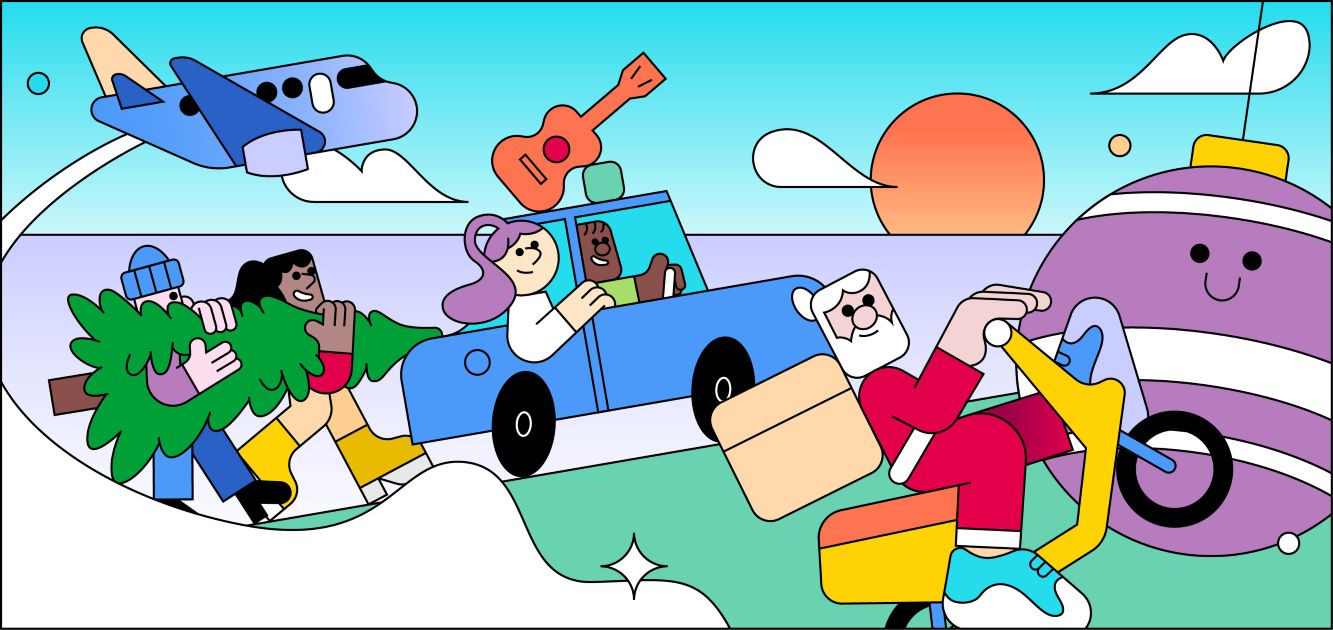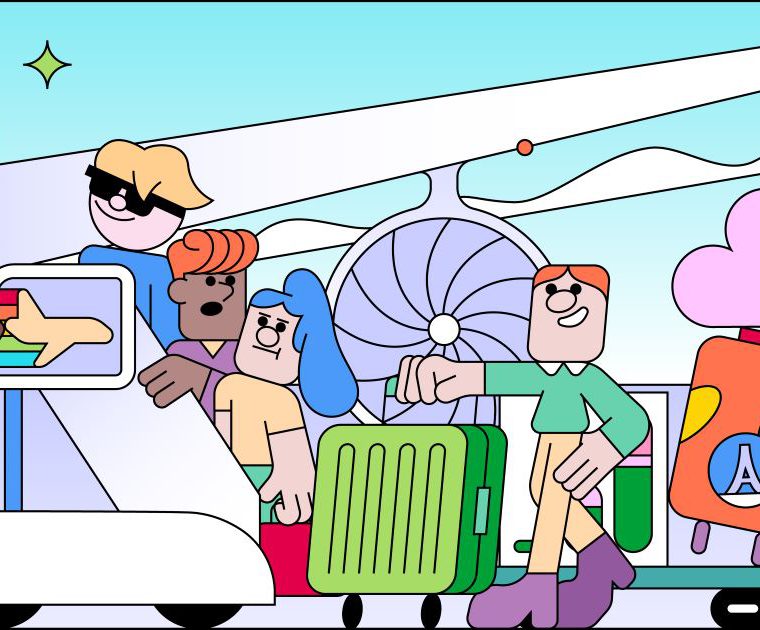Pumpkin spice is back in stores, and you know what that means: the holidays — and holiday travel — are already top of mind. This year, holiday travel experiences are going to make a splash. So it’s time to get your holiday marketing ready to cannonball right in.
Experiential gifts are a growing favorite across demographics, and your holiday marketing should reflect that. That’s why we’ve rounded up the holiday travel marketing tips and tricks you need to know to sell holiday travel experiences this season. Forget the wrapping paper. It’s time to take a trip!
So what are the latest trends in holiday travel? How can you market holiday travel experiences effectively? And how can influencers boost holiday travel sales? We’ll answer all these questions and more so you have all the info you need to start planning kick-butt travel marketing for the upcoming holiday season.
And if you happen to be a special kinda numbers nerd, may we offer you a look at our roundup of 2024 travel stats? You can access all the extra data you need to create great campaigns. But for now, we’re focused on holiday travel, so let’s jump in.
Let’s Frame Travel Within the Context of a Growing Desire for More Experiential Gifts

When it comes to holiday marketing, we often talk about the meaning of the season. People want to spend time with loved ones, enjoy the nostalgia of holidays past, and create lasting memories together. We recently published an article about how Gen Z is leveling up Halloween, and both experiences and spending time together were listed as holiday themes younger consumers take very seriously. It makes sense then, that a growing percentage of Americans plan to prioritize experiences over physical gifts this season.
As of Q4 of 2023, a whopping 92 percent of Americans hoped for experiential gifts over material ones for the holiday season. That’s up from 77 percent the year prior. And experts expect this trend to continue into this holiday season as well.
Of those who want to ditch the ribbons and bows for memories, most (51 percent) want to travel or take a trip. Four in ten would prefer to see a concert or show. And three in ten would like to be gifted outdoor experiences like hiking or skiing. Meanwhile, 27 percent have their fingers crossed for a museum visit.
It’s worth noting that travelers prioritize longer, slower travel with more experiential gifts during the trip itself. For example, scuba diving lessons and certification have become popular experiential gifts for traveling families looking to spend some time with their kids without screens or distractions. So keep in mind the holiday travel experiences vacationers can engage in once they’ve booked their holiday travel. There are layers to this particular type of memory-making (and marketing)!
What You Need to Know About the Modern Holiday Traveler
In 2024, the modern holiday traveler keeps values on par with value. That means they’re prioritizing time spent with loved ones, making a positive impact on themselves (with wellness experiences) and on their destinations (with eco-conscious travel), plus slowing down to ease into deeper experiences.
Who’s Doing the Traveling?
Nine in ten Americans plan to take a trip at some point this year, and around half (between 40 to 50 percent) plan to take a trip this holiday season. Turns out, 80 percent of Americans believe travel is important for their well-being. That well-being is top of mind for those traveling for the holidays or gifting future trips during the holiday season.
Why They’re Traveling?
Modern travelers are ticking destinations off their bucket lists that may have been on their minds since before the pandemic. And they want to make the most of their time away by resting and recharging, and deeply experiencing locations by way of food, sightseeing, environment loving, and more.
The most popular holiday travel experiences this year include:
- Concerts
- Stargazing
- Foodie Itineraries
- Fancy Train Travel
- Diving & Eco Activities
- Biohacking & Wellness
Of course, the modern holiday traveler covers a broad range of demographics. You know, here at The Shelf, we always advocate specific targeting for your campaigns. So you may be asking yourself, how do different generations prefer to travel during the holidays? We’ve got you covered. Let’s dig into some generational travel trends.
A Look at Holiday Travelers By Generation
Gen Z Holiday Travel Preferences
Okay. Let’s kick things off with everybody’s favorite young adults, Gen Z. Gen Z is most likely group to travel in 2024 out of any generation, with 84 percent of Gen Zers planning to take a trip in the next year. They plan their trips using digital tools like social media and AI. 89 percent search for travel destinations on TikTok. And 75 percent use AI-powered tools.
Gen Z prefers excitement over relaxation when they travel. 57 percent go for experiential value, immersive exploration, and authentic experiences rather than relaxation and downtime. That makes them the perfect target demo for holiday travel experiences.
Most of them (like, 65 percent) expect to pay more for travel this year than last, but 97 percent are worried about rising costs affecting their travel plans. So if you’re in the market of high experiential value, budget-friendly holiday travel experiences, Gen Z may be the demo for you.
How Millennials Do Holiday Travel
Millennials are the second-most likely to travel in 2024, with 77 percent planning to take a trip in the next 12 months. But they travel differently than their Gen Z counterparts. Most Millennials (83 percent) want to feel cared for when traveling. Six in ten say the purpose of their travel is to rest and recharge. Compare that to 52 percent who prefer to travel for exploration and adventure.
Millennial parents are especially keen on multi-generational holiday travel this year. (More on that in a bit.) It makes sense that 91 percent of Millennial parents prioritize family-friendly destinations when planning holiday travel.
Millennials are also spending more on travel this year, with 72 percent spending more than last year. Despite the increase, Millennials still spend less than any other demographic on travel. They want their money to go far on relaxation and convenience. So if you’re marketing wellness and relaxation-based holiday travel experiences, Millennials may be the ones you target with your holiday campaigns.
Gen X’s No-Stress, No-Mess Holiday Travel Plans
Gen Xers, born between 1965 and 1980, are shifting toward stress-free, solo, or friend-based vacations rather than family trips. More than 60 percent of Gen X travelers prioritize escaping daily stress, the highest of any generation. With empty nests and retirement on the horizon, many are embracing their newfound freedom to explore the world on their own terms.
Convenience is a key factor for this group, with 71 percent appreciating travel apps that reduce stress and 79 percent expecting seamless tech integration in their travel accommodations. Resort destinations appeal most to Gen X (61 percent), but a significant 39 percent still enjoy city trips. Culinary experiences are another major focus, with 87 percent prioritizing local cuisine and 81 percent enjoying hotels with great restaurants.
Despite being in their peak earning years, financial pressures influence Gen X’s travel decisions, driving them toward budget-friendly options while still seeking memorable, immersive experiences.
Holiday Travel Trends for the Over-60 Crowd
A majority of Baby Boomers over 60 plan to travel this year. Three in four have a vacation on the horizon. However, they are the least likely generation to travel internationally, with only 21 percent planning to leave the country.
Baby Boomers are willing to splurge on all-inclusive packages, and they’re the least likely to compare pricing and look for budget-friendly options. This generation loves to book trips that require little planning and feature all-inclusive options that include immersive activities with minimal research. They’re all about experience and convenience.
So if you’re marketing holiday travel experiences to consumers over the age of 60, you may want to go for the most conveniently packaged approach. They’re willing to pay the big bucks for experiential value with minimal lift and planning.
Multi-Generational Travel: A Growing Opportunity
Multi-generational travel is a big trend in 2024. In fact, half of parents plan to travel with their kids and kids’ grandparents this year. These trips spanning three generations provide a lot of benefits, especially for parents who want to enjoy their holiday vacations.
These multi-generation trips are more popular for light-itinerary, relaxing destinations. Think beaches and resorts over big-city sightseeing excursions. Multi-generational travel requires destinations and holiday travel experiences to include fun for the whole family. The less logistical planning the better. Instead of itinerary-heavy trips with multiple stops, families look to stay put and go deep with local, bonding experiences.
Popular multi-generational holiday travel experiences include:
- Safaris
- Pool Days
- Beach Days
- Scuba Diving
- Walking Tours
- Dance Lessons
- Cooking Classes
Traveling with multiple generations allows for memory-making across the family tree. And grandparents often provide much-appreciated childcare for busy parents anxious to unwind. It’s great for the kids too. And for more than getting quality time with their grandparents. A majority of parents (84 percent) say that multi-generation travel made their kids more open and adaptable to new experiences.
This multi-generational trend is also great news for marketers. Because these trips span multiple target demos, there’s fun for the whole family and the whole marketing team.
Marketing Strategies for Holiday Travel Campaigns
[Slaps palms together]As the General told Mulan, let’s get down to business. One of our favorite strategies for holiday marketing, especially for holiday travel experiences, is influencer marketing. We know, we know, classic to hear that the influencer marketing agency loves holiday influencer marketing. But hear us out!
Holiday travel experiences are all about, well, experience! You’re not marketing a shiny new product that you can capture in a single image and witty description. We’re talking about selling consumers on an entirely new destination, filled with new sights and smells and sounds. Or activities that they’ll remember for a lifetime! That means your campaigns should focus on storytelling, authenticity, and forging an emotional connection with audiences.
The best way to communicate the impact and allure of these destinations and holiday travel experiences is to hear from someone who has experienced them. Cue the influencers!
Where Influencers Fit Into Your Holiday Travel Marketing
Influencers are a game-changer when it comes to marketing holiday travel. They don’t just showcase experiences—they take their followers along for the ride. All of a sudden, a day-in-the-life vlog transforms into aspirational holiday travel content. The key here is authenticity, which is difficult to replicate with traditional ads. Influencers can make holiday travel experiences feel immersive, accessible, and inspiring.
Travel content is one of the most engaging types of influencer posts because it combines aspirational experiences with practical insights. Influencers get to enjoy amazing trips while creating dynamic, conversion-driven content for your brand. And the benefits are mutual: when influencers are happy, they produce better, more organic content, which drives higher engagement and conversions.
But not all influencers are created equal. Partnering with the right influencers is key. Micro-influencers with highly engaged niche audiences often provide better ROI than mega-influencers who cater to broader audiences. Additionally, selecting influencers who align with your brand values or target destinations ensures the content resonates with the right demographic.
Play to the Algorithms: Different Platforms and Content Formats to Hit Important Campaign KPIs
The algorithms powering social media platforms vary based on the type of content, and brands can use these differences to their advantage when planning influencer campaigns.
Interest-Graph Algorithms for Awareness (Top-of-Funnel)
Interest-graph algorithms, found on platforms like TikTok and Instagram Explore, thrive on user interests rather than follower counts. Brands looking to build awareness quickly should focus on influencer content designed to capture broad interest—think destination-focused reels, packing hacks, or exciting activity-based videos.
A couple of things to keep in mind. The first is that 1 in 5 consumers use TikTok to search for content related to travel destinations and experiences.

The second thing is that social feeds are typically responsive to the search behaviors a user performs on other channels. So, if someone’s already starting to look at travel content for this holiday season, or even looking to take advantage of holiday travel deals for travel in 2025, their social feeds will likely start reflecting travel-related content. A user’s search behaviors off-platform create the perfect bridge to find your campaign when they open their social app.
For top-of-funnel efforts, influencers can create snackable, viral content on TikTok or Instagram Reels to push their holiday travel experiences to a wider, targeted audience based on specific travel interests (e.g., adventure travel, solo travel).
How-To Content on YouTube for Mid-Funnel Engagement
At the mid-funnel stage, when your audience is looking for more detailed information, long-form content works best. YouTube’s algorithm rewards watch time and engagement, making it the perfect platform for travel influencers to post in-depth guides or how-to content. An influencer can create a #packwithme like this one from UK-based lifestyle vlogger Brogan Tate. Or a video showing step-by-step itineraries for a budget holiday trip or top tips for planning a multi-generational vacation. This content builds trust and helps nurture the audience toward conversion.
Storytelling on Instagram Stories for Lower Funnel
Instagram Stories and Highlights, on the other hand, are ideal for fostering personal connections and moving audiences toward action. The “episodic” nature of Stories lets influencers build out more personal, story-driven content that gets viewers invested in the travel experience. Through storytelling, influencers can highlight their favorite holiday destinations, unique local experiences, or even exclusive deals. Stories also have swipe-up links (or link stickers) that brands can use to push viewers directly to booking pages or special promotions, making it easy for audiences to take action.
How to Incentivize Action in Influencer Campaigns
Driving awareness is important, but what really matters is getting potential travelers to take action. Here are some strategies brands can use to incentivize conversions in influencer campaigns:
Exclusive Offers
Influencers can offer followers exclusive travel discounts, such as a special promo code for holiday packages or early bird deals for booking by a certain date. The key here is to create a sense of urgency, making followers feel like they’re getting access to something others aren’t.
One popular travel method, especially for solo travelers is to participate in a group trip. Travel and lifestyle influencer Kemoy Martin created a Reel on Instagram showcasing affordable travel destinations in partnership with travel community company Limitless Voyagers. He broke down costs, shared insider tips on the best times to travel, and showed how travelers can explore top destinations without breaking the bank. This kind of content works well for cost-conscious travelers looking for experiential value. Plus, adding pricing insights and personal footage lends credibility and makes the destinations feel attainable. In this post Kemoy lists the dates of upcoming travel experiences.
Limited-Time Offers and Exclusive Experiences
Urgency and scarcity—tried and true motivators. Offering limited-time or exclusive experiences can push users to take action. For instance, Apple Vacations ran a “Secret Resorts” campaign that highlighted affordable luxury destinations that weren’t yet on people’s radars. Brands can work with influencers to promote special holiday-themed experiences, like a Christmas market tour in Europe or a unique New Year’s Eve event in a tropical destination, that are available for a short period. This urgency encourages followers to book immediately to secure a spot.
Last-Minute Deals
For travelers who wait until the last minute to plan (or who just need an extra push), offering discounted rates on last-minute holiday deals can be highly effective. Influencers can create content highlighting these limited-time discounts, urging their followers to take advantage before time runs out. Showcasing spontaneous, affordable holiday travel opportunities—like a last-minute trip to the mountains or a quick weekend getaway to a beach destination—gives your audience the chance to feel adventurous while saving money. These types of deals resonate especially well with Gen Z and Millennials, who are often motivated by cost savings and spur-of-the-moment travel.
Contests and Giveaways
Travel brands can partner with influencers to host contests or giveaways. Followers could enter by sharing their travel plans, tagging friends, or following both the brand and influencer. Giveaways not only build buzz around the campaign but also expand the brand’s reach as participants share the contest within their own networks.
User-Generated Content (UGC) Campaigns
Encourage followers to participate in the experience by creating their own content. Brands can launch a campaign hashtag and ask followers to share their dream holiday destinations or favorite travel moments. Offering a prize—such as free flight tickets or a travel voucher—can drive engagement and amplify the brand’s reach. This strategy taps into the community-driven nature of social platforms, making followers feel more connected to both the influencer and the brand.
Loyalty Programs or Rewards
Partnering with influencers to highlight your brand’s loyalty program benefits can be a powerful incentive for travelers. Influencers can emphasize perks like exclusive upgrades, luxury amenities, or points that can be redeemed for future trips. Loyalty programs resonate particularly well with frequent travelers who value the long-term benefits of booking through the same brand, and influencers can help showcase why joining your program offers them unmatched travel rewards.

Make the Most of Your 2024 Holiday Travel Campaign
Folks, we’re smack-dab in the middle of the holiday marketing season (believe it or not). Successful travel marketing combines creativity, technology, and strategic partnerships. Influencers can breathe life into your campaign by making your destinations feel real and accessible, while your tech – i.e. predictive analytics – allows you to fine-tune your efforts and optimize in real time for maximum impact.
When planning your holiday travel campaigns, keep these trends and tools in mind. Whether it’s targeting Gen Z’s love of adventure, showcasing budget-friendly options for Millennials, promising a lil’ peace and quiet to Gen Xers, or offering all-inclusive luxury to Baby Boomers, a well-rounded approach will help you reach your audience effectively.
If you need help crafting a campaign that leverages the latest tools and influencer strategies, we’ve got your back, Jack! Talk to one of our super creative, super strategic, super smart humans and we’ll help you create a data-driven, high-impact campaign that exceeds your marketing goals and delivers real results.




